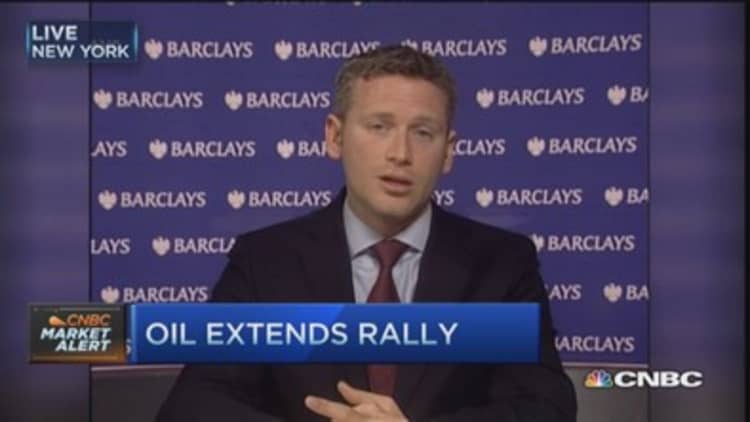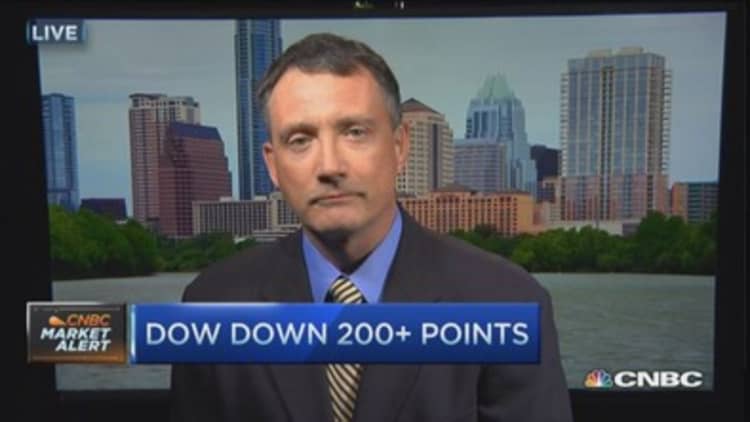


U.S. oil companies have quickly become the new swing factor on the world energy stage, and their ability to handle price volatility could be key in determining future oil prices.
"This is a market that's far from settled down, and it's a market that's going to be a lot more volatile," said Daniel Yergin, vice chairman of IHS. "What kind of prices do you need to keep it going?" Yergin said. "What does it mean when you say the U.S. is the new swing producer? It's much easier to swing down than swing up."
Following Saudi Arabia's lead, OPEC put the onus on U.S. shale production when it declared last November that it would not cut output unless its high-cost rivals did. Oil prices, already in decline, plunged.
"The shale industry produces 4.5 million barrels a day, exceeding the combined production of Kuwait and the United Arab Emirates," said Fadel Gheit, Oppenheimer & Co. energy analyst. "It did not exist 10 years ago. That's why OPEC and Saudi Arabia could not figure out what shale was all about. They missed the shale revolution. Finally, they had to make room for shale and frackers at the big table."
Oil prices have recently rebounded from a more than 50 percent decline since June, and the question now for the industry is whether prices have found a bottom and what the new reality will be for crude prices. West Texas Intermediate crude futures were trading at about $55 per barrel on Monday morning.
"People forgot that cycles mean that prices go down as well as up. The longer we had $100 oil, the more people thought it was well grounded and was the new norm, and they were counting on Chinese economic growth and growing demand to maintain it and assuming that OPEC would do what it had done in the past and cut production," Yergin said.
Oil prices will recover, but they are unlikely to go where they were before the collapse. Near term, it's very slushy … but the dust has not settled yet, because the fracking industry is young. It has not gone through a crisis before.Fadel GheitOppenheimer & Co. analyst
Even with a dramatic more than 50 percent drop in rig count, U.S. oil production remains close to 40-year highs. The industry exceeded 9 million barrels in November, and production has been about 9.3 million barrels a day recently. While U.S. production remains high, Saudi Arabian output has increased to 10.3 million barrels, and Russian output reportedly has remained steady, a bearish formula for prices.
Hundreds of global industry executives, regulators and other officials will convene in Houston this week for the annual IHS CERAWeek Energy Conference. Last year the U.S. shale industry was the youthful upstart at the influential conference, taking the stage as high oil prices fueled unprecedented growth. This year in Houston the industry has faced its first bumps, and the discussion for U.S. oil producers—some profitable, others not—will be how to control costs in an uncertain price environment.
Gheit said low prices are an advantage for some companies and a hardship for others. For instance, a cash-rich major like Exxon Mobil could be well placed to do a major acquisition in a low price environment.
Royal Dutch Shell and BG Group, the two biggest producers of liquefied natural gas, announced this month that they are hooking up in a near-$70 billion deal in a weak LNG pricing environment.
More deals are expected in the oil sector. "The longer oil prices remain low, the more likely more and more companies will throw in the towel. The reason we haven't seen a lot of mergers and acquisitions is, the potential seller is eyeing $100 oil, and the potential buyer is thinking oil prices could get stuck at $50," Gheit said.
Gheit said oil will probably settle in the $70-a-barrel range, and the U.S. unconventional industry will emerge from the collapse in prices as a changed industry.
Read MoreOil export ban 'a sanction against ourselves': Senator Murkowski
"Oil prices will recover, but they are unlikely to go where they were before the collapse. Near term, it's very slushy … but the dust has not settled yet, because the fracking industry is young. It has not gone through a crisis before," Gheit said. He added, "Out of the crisis, it will be more grown up, more efficient, more responsible. Lower oil prices will force more discipline. They need $65 oil to survive, not to make money or break even."
License to export
The IHS CERAWeek conference kicks off Monday with a panel featuring Sen. Lisa Murkowski, R-Alaska, who chairs the Senate Energy and Natural Resources Committee. Joining her will be ConocoPhillips CEO Ryan Lance. Both are proponents of changing U.S. law to allow for the export of crude oil, prohibited with the exception of some oil exported from Alaska or as an export into Canada.
"The export of crude oil is going to be an incredibly hot issue at the conference," Yergin said. "I believe in some fashion it's going to happen." The U.S. has recently allowed companies to export condensates or lightly refined oil, but the amount is relatively small.
The industry has argued, particularly as prices fell, that by allowing the export of the light sweet crude that is abundant in the U.S., producers could command higher prices and a steady market for their product. That would then help the industry maintain higher production levels and close the price gap between U.S. crude and foreign oil.
In recent congressional testimony, ConocoPhillips' Lance said exporting light oil output from unconventional wells in the U.S. makes sense because it cannot be refined in many U.S. refineries. The U.S. could then continue to import heavier crude, which can be refined in the U.S.
The U.S. produces about 9.3 million barrels a day and imports about 7 million barrels. Crude-oil exports totaled 503,000 barrels a day last week, according to the Energy Information Administration.
Read More Watch oil services stocks: Analyst
"Repealing the crude-oil export ban is vital to the health of the domestic E&P business and will incentivize ongoing investment by industry. By removing obstacles to investment, we can help protect jobs in this current low-price environment and create significant numbers of new jobs in the future," Lance told the Senate energy panel recently.
The sleeping North American giant
Another major topic of discussion at IHS CERAWeek will be the opening of Mexico's energy market to new investment.
The U.S. and Canada together are already viewed as an energy 'powerhouse,' and the addition of more Mexican production would result in a new North American energy axis that some analysts say could become increasingly independent. Mexico's government-controlled Pemex now pumps 2.4 million barrels a day, two-thirds of its product a decade ago.
But since Mexico announced eight months ago that it would put dozens of oil fields up for bid to private companies, the price of oil has dropped dramatically—and the question is, will private companies be as eager as they might have been last year. The first auctions will be awarded for 14 exploration blocks in shallow waters in July.
Some investment firms see big opportunities in Mexico's energy sector, closed for more than 75 years with Pemex as a state-owned monopoly. "The broad story is Mexico is unfolding, and we have been looking at it for a while," said BlackRock managing director and chief operating officer for BlackRock Infrastructure Anne Valentine Andrews. "They're very interested in doing it with international best practices. They're very interested in doing it the right way."
Read MoreFor crude oil, this looks like 2009 all over again
BlackRock last month announced its first Mexican infrastructure investment, along with First Reserve. The agreement was with Petroleos Mexicanos to acquire about 45 percent in two natural gas pipelines. They are the first major Pemex midstream assets to be built in partnership with foreign funding since the approval of Mexico's Constitutional Energy Reform in 2013. The pipelines will transport natural gas from the Eagle Ford shale in Texas to Mexico.
Andrews described the changes in Mexico as equivalent to "waking a sleeping giant."
"We have plans to effectively set up our direct investing in Mexico City. That's the phase we're in right now. These transactions were the start of that. We view that Mexico will be the base and that we will then extend our reach into other Latin America countries," she said.
Besides Lance, the five-day CERAWeek conference will feature ExxonMobil's Rex Tillerson; BP CEO Robert Dudley; Statoil CEO Eldar Sætre; Occidental Petroleum CEO Stephen Chazen; Total CEO Patrick Pouyanne, and Petroleos Mexicanos CEO Emilio Lozoya Austin.





